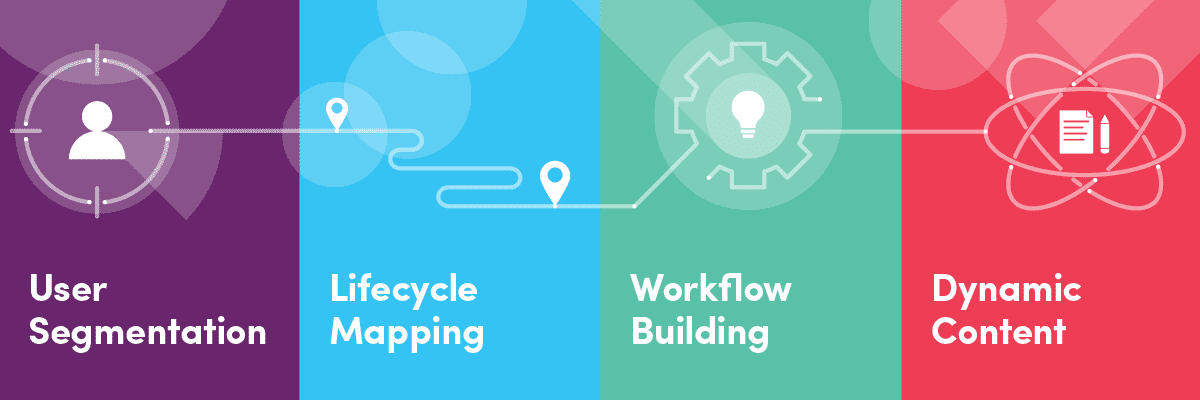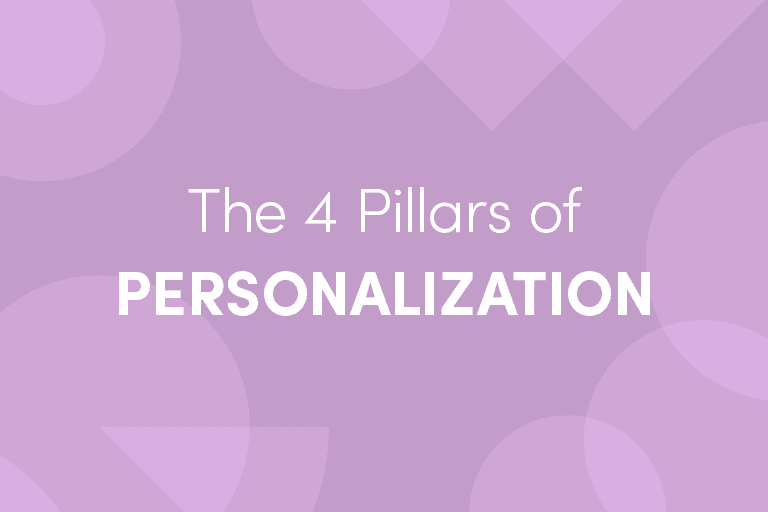Personalization is more than a simple tactic to drive clicks and conversions. Personalization is rooted in strategy, crafted in execution and manifested inside customer experience.
Buzzwords aside, personalization is a process. But, the results are worth it. Ad Age found that 80% of consumers do business with companies offering personalized experiences.
Introducing the “Core Four” Pillars of Personalization
We posit that there are four foundational pillars of personalization:
- User Segmentation: finding the perfect audience
- Lifecycle Mapping: creating immersive journeys
- Workflow Building: engaging at opportune moments
- Dynamic Content: connecting with tailored messaging


Each pillar represents a critical step of the personalization process and the more proficiently you’re able to master each one, the more marketing possibilities you unlock. When executed in tandem with one another, you’ve created a scalable framework for not just personalization, but individualization.
Let’s look at each of them in greater detail.
1. User Segmentation
Any marketer worth their salt knows what segmentation is and why it matters—51% of us recognize it as our most effective personalization tactic. Dialing in exactly which customers you want to want to reach is the first action step of any campaign.
Modern marketers have more access to customer data than ever before. But without a modern application strategy accounting for this new depth and breadth, falling back on legacy segmentation strategies like basic attributes, general lifecycle, RFM targeting, among others, seems like the easiest choice to make.
Instead, let’s redraw the lines of demarcation between segments and push customer data further. Top-line demographic and behavioral data as segmentation filters only scratch the surface—understanding contextual data to understand customer motivations is the new segmentation playing field.
With a more sophisticated segmentation strategy in hand, identifying key audiences and the types of resonant content that appeals to them becomes almost second nature.
Modern Segmentation Calls to Action
- Look deeper into behavioral data to infer how your products and services make your customers feel. Leverage this level of nuanced data as influential segmentation criteria.
- Define customers by more than demographic personas. Certain data types like engagement, purchase frequencies and average order value are impactful at the individual level, but less so when applied to groups.
- Learn from, but don’t lean too heavily on historical data as the sole predictor of behaviors. Consider the significance of the role months-old data actually plays in your segmentation strategy.
Segmentation Resources
- 3 Types of Customer Segmentation Your Marketing Team Can’t Ignore
- How to Use Mobile Geolocation Data to Drive Growth
- 4 Overlooked (but Valuable) E-Commerce Segments to Target
2. Lifecycle Mapping
When it comes to the modern-day lifecycle, there are two critical elements marketers need to consider: a guiding stage-by-stage framework and a readiness to respond when customers choose to go their own way.
A comprehensive lifecycle is one born from methodical planning and customer-first creativity. For simplicity, we think about the lifecycle in three basic stages—activation, nurture and re-activation. Each stage has its own overarching purpose and objectives that customers must reach before advancing into the next one.
Thinking critically through your ideal customer experience and considering the full spectrum of possible interactions will clarify where and when marketing actions can help customers overcome engagement hurdles.
Don’t overlook these areas of customer importance:
- Web and app activities
- Browsing and buying behaviors
- Cross-channel messaging engagements
- Customer service and support encounters
- And more
Now that methodical plan above is all well and good, but that assumes linear customer behavior. While it’s true that a good percentage of your customers will venture through that lifecycle in a “traditional” stage-by-stage manner, there are plenty who won’t. Data continuity ensures any actions like those mentioned above responsively align them to the right stage of the lifecycle.
Remember, customers aren’t obligated to play by your rules, but you have to play by theirs—meet them on their terms and make sure your intended customer experiences support their own.
Modern Lifecycle Mapping Calls to Action
- Define the key stage-by-stage goals your customer should accomplish before advancement. Use a customer-first lens to set the right guidelines for familiarity, trust, needs, and their perceived values.
- Leverage data to optimize throughput. Set appropriate progression thresholds, unblock points of friction and optimize the experience with data-driven learnings.
- Build a comprehensive end-to-end journey that maximizes customer satisfaction. But, be ready to appropriately respond to customers entering and exiting at their will.
Lifecycle Mapping Resources
- How Fender Plays All the Right Notes of the Customer Journey
- Opendoor’s 7-Step Framework for Marketing Automation Success
- Top 10 Email and Mobile Campaigns Every Brand Needs
3. Workflow Building
To design truly immersive campaign experiences, marketers need freedom and flexibility—the freedom to create with full access to all customer-facing data and the flexibility to leverage it inside sophisticated workflows.
For instance, freedom means building workflows that guide customers down the right path based on real-time data feedback. After a member of X audience performs Y action, do Z within this timeframe—there’s boundless potential for growth and experimentation once empowered to create without obstruction.
The data that flows through and powers workflows in real-time is the marketer’s secret weapon to automating customer surprise-and-delight. Flexibility begets dynamism, and designing workflows that automatically add or remove eligible people from certain campaigns or message queues because of their individual behaviors drives momentum throughout your lifecycle.
Build the workflows that adhere to The Golden Rule: market to others in the same way you would want to be marketed to—keep the experience timely, relevant and aligned with the customer’s specific needs.
Modern Workflow Building Calls to Action
- Let the customer experience be the guide. Use workflows as guardrails that maintain engagement, but let customer data dictate the direction of the journey.
- Don’t overlook the nuances of customer interactions. Create workflow rules that infer customer intent from repeat actions or behaviors and respond accordingly.
- Carry messages over the channels your customers care about. Foster engagement by bringing messages of value to their native channels.
Workflow Building Resources
- How to Create a Cross-Channel Onboarding Campaign in Iterable
- How Autolist Drives Personalization at Scale with Workflows
- How ShopRunner Uses Real-Time Data to Power Emails
4. Dynamic Content
“Content,” in the marketing sense, is usually the de-facto standard for judging how personalized something is. It’s certainly an effective indicator, but as you can tell from the other three pillars, personalization comprises much more.
Content is a visual representation of user, event, product, and service data come to life through merge tags, connected data feeds and APIs, and dynamic data relationships through tools, like Iterable Catalog.
Level of personalized content sophistication—a marketer’s ability to transform their data input into personalized output—typically falls somewhere within one of these three levels:
Level 1
Reactive personalization derived from user attributes and event data. It’s a one-to-many approach and is applicable to large audience segments. These are the easiest tactics to implement using customer attributes like first name, event milestones (e.g. birthdays), or system events like cart abandonment.
Level 2
Proactive personalization combining user and event data with externally managed data. It’s a one-to-some approach and is applicable to smaller, targeted segments. This incorporates customer behaviors and third-party data and is more resemblant of individually targeted messaging (e.g. geo-specific services of personal interest).
Level 3
Individualization formed from dynamic relationships between user attributes and detailed product data. It’s a one-to-one approach that appeals specifically to each individual. This takes into account various profile, behavioral, lifecycle data points to create user-specific dynamic content experiences that are unique to each user.
Each level plays an important role in dynamic content creation. Strategically building message templates capable of leveraging the full compendium of customer data increases relevance and opens new doors for scale.
With dynamic content, it’s entirely possible to consistently connect multiple sources of data and consistently “wow” millions of customers with meaningful messages.
Modern Dynamic Content Calls to Action
- Maximize the value inside your stack-wide data. Even nuanced details about behaviors or actions captured by other tools provide valuable context for improving content alignment to each individual.
- Build for broad appeal while connecting with targeted content. Learn where in your workflows to deploy specific messages and dynamically populate them with individualized content that increases message impact.
- Align your levels of effort appropriately to ROI. Don’t waste valuable time and resources building highly dynamic message components if they aren’t impacting key performance metrics.
Dynamic Content Resources
- Dynamic Content Deconstructed: 3 Building Blocks for Success
- 3 Techniques for Mastering the Art of Content Personalization
- 5 Cool Personalization Ideas You Haven’t Thought Of
4 Pillars of Personalization, 1 Foundation to Long-Term Success
Now that you understand these “Core 4” pillars of personalization, keep this in mind: Personalization is ultimately a long-term strategy that takes time to develop. In fact, according to Gartner, “Only 40% of marketers report having a clear personalization strategy and roadmap.”
With the four pillars we’ve covered today, think about your current process and consider how you might strengthen each one through customer data collection, campaign automation, experimentation and other factors.
When in doubt, sign up for a personalized demo and see why Iterable is the best foundation for building these pillars from the ground up.
































